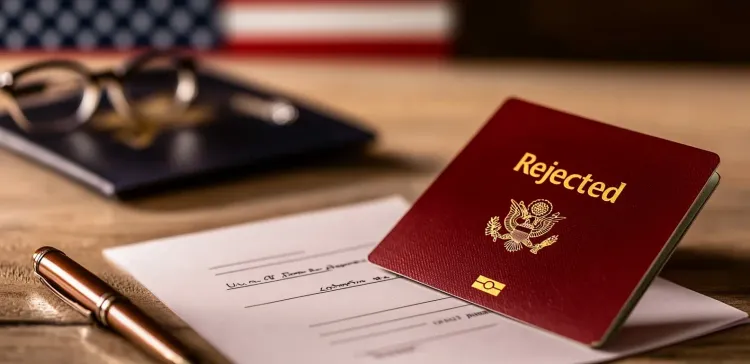USA rejecting Visa

Destination (from India)
Dates of Travel (optional)
List of Content
- •What Is an F-1 Visa?
- •F-1 Visa Rejections Hit a 10-Year High
- •1. Non-immigrant Intent
- •2. Incomplete or Inconsistent Documentation
- •3. Financial Inadequacy or Lack of Clarity
- •4. Over-Reliance on Counsellors and Agencies
- •6. Regional Disparities in Approvals
- •F-1 Visa Rejection vs Denial: Understanding the Difference
- •How to Strengthen Your F-1 Visa Application
- •Conclusion
- •Frequently Asked Questions
What Is an F-1 Visa?
The F-1 visa is a non-immigrant visa issued by the United States government, allowing international students to temporarily live and study in the U.S. It is the most common visa type for academic studies and is intended for those enrolling in a full-time programme at an accredited university, college, high school, or even language training institute.
In fact, over 90% of student visas issued by the U.S. each year fall under the F-1 category. This visa is specifically designed for students pursuing academic or language-based education. By contrast, the M-1 visa is reserved for those enrolled in vocational or non-academic programmes, such as technical courses or training schools.
What sets the F-1 visa apart is its clear purpose and structure. To qualify, students must be accepted by a U.S. institution that is authorised by the Student and Exchange Visitor Program (SEVP). They must also prove that they have the financial means to support themselves throughout their course, and that they intend to return to their home country after completing their studies.
It is important to understand that the F-1 visa does not grant permanent residency. It allows students to remain in the U.S. only for the duration of their academic programme, along with a short grace period before and after the course. While students on an F-1 visa may be eligible to work in limited circumstances, such as on-campus jobs or Optional Practical Training (OPT), the primary focus must always remain on education.
In short, the F-1 visa is a gateway for international students to gain a world-class education in the U.S., but it comes with responsibilities. Understanding the rules that govern it is the first step towards a successful application and a smooth academic journey.
F-1 Visa Rejections Hit a 10-Year High
If you’re planning to study in the US, here’s something you’ll want to know. The number of student visa rejections—specifically for the F-1 visa—has shot up to the highest it’s been in a decade. And Indian students are feeling the heat more than ever.
Out of approximately 679,000 visa applications received between October 2023 and September 2024, nearly 279,000 were denied–placing the overall rejection rate at 41%. This is the highest denial rate for student visas in over a decade and marks a clear increase from the 36% rejection rate reported the previous year. To put that in perspective, in 2022–23, around 700,000 applications were filed, and about 253,000 were rejected. So yes, the jump is significant.
This isn’t just a number game. For thousands of students dreaming of heading to American universities, a visa rejection can mean lost time, money, and opportunities. The rising denial rate has sparked a wave of concern, especially in India, where families often make big financial and emotional commitments for overseas education.
Key Reasons Behind the Rising Rejection Rates
The increasing number of student visa rejections in recent years has become a growing concern, particularly for Indian students. While the United States remains a top destination for international education, the F-1 visa approval process has become more stringent. Understanding why these rejections are happening is essential for students who are planning to apply.
1. Non-immigrant Intent
The most frequently cited reason for rejection is the failure to prove non-immigrant intent. The F-1 visa is a non-immigrant visa, which means applicants must show that they intend to return to their home country after completing their studies. This can be challenging to prove, especially for students who may have strong ties to the U.S., such as family members residing there.
If an interviewing officer is not convinced that the applicant will return to India, the visa may be denied under Section 214(b) of the U.S. Immigration and Nationality Act. Unfortunately, this decision is often subjective and based on how well an applicant presents their case during the visa interview. Even students with confirmed admission and full financial backing can face rejection if they cannot adequately communicate their long-term plans to return home.
2. Incomplete or Inconsistent Documentation
Another common reason for visa denial is errors or inconsistencies in the documentation submitted. Students are required to provide a range of documents—admission letters, financial proof, academic transcripts, and more. If any part of the paperwork is incomplete, unclear, or inconsistent with the information provided during the interview, the consular officer may question the applicant’s credibility.
Furthermore, if a student’s academic performance in the past appears weak or erratic, officers may doubt their ability to successfully complete a course in the U.S. This reinforces the importance of submitting organised, truthful, and complete documents that align with the information shared verbally.
3. Financial Inadequacy or Lack of Clarity
Financial strength is another crucial aspect of the F-1 visa process. Students must demonstrate that they can support themselves for the duration of their studies without needing to rely on unauthorised work. If an applicant cannot clearly explain their funding sources—such as scholarships, family income, or loans—they may be deemed financially unprepared.
Additionally, officers sometimes raise concerns when funds come from informal or unverifiable sources. Even genuine financial support may be questioned if the details are not transparent and well-documented. It is essential for students to have not only sufficient funds but also clearly laid-out explanations for how those funds will be used.
4. Over-Reliance on Counsellors and Agencies
In some cases, students depend heavily on visa agents or education consultancies who prepare answers or documents on their behalf. This can backfire during interviews if the student fails to respond confidently or accurately to questions. Officers are trained to detect rehearsed or memorised responses, and this may lead to suspicion about the applicant’s genuine intent and preparation.
6. Regional Disparities in Approvals
Recent reports suggest that visa rejection rates vary significantly by region. For example, students applying from certain parts of India—such as Telangana and Andhra Pradesh—have experienced rejection rates as high as 50–60%, well above the national average. This may be linked to perceived patterns of previous applicants from those regions overstaying visas or violating conditions, which unfortunately impacts new applicants.
F-1 Visa Rejection vs Denial: Understanding the Difference
While the terms "visa rejection" and "visa denial" are often used interchangeably, there are key distinctions between the two within the context of the U.S. visa process.
A visa denial is a formal refusal of a visa application by the U.S. Embassy or Consulate. This can occur when an applicant fails to satisfy one or more of the eligibility requirements under U.S. immigration law. Common grounds for denial include lack of non-immigrant intent, insufficient financial evidence, misrepresentation, or concerns about the authenticity of the documents submitted. Applicants are typically informed of the specific section of the Immigration and Nationality Act (INA) under which their application has been denied.
In contrast, a F-1 U.S. visa rejection generally refers to an ineligibility or administrative issue that leads to the visa not being issued. This might be due to incomplete documentation, missing information, or failure to meet basic eligibility requirements. Rejection does not necessarily reflect negatively on the merits of the applicant but indicates that the application was not complete or did not adhere to procedural guidelines.
Understanding this distinction is crucial. A denial reflects a decision based on substantive grounds, whereas a rejection often stems from procedural shortcomings. Both require different approaches when considering a reapplication.
How to Strengthen Your F-1 Visa Application
If your F-1 visa application has been denied or rejected, it is important to understand the possible causes and take meaningful steps to improve your chances in the future. While there is no formal appeal process for visa denials, applicants may choose to reapply with a stronger case. Here are several measures that can help reinforce your application:
1. Review and Address the Reasons for Denial
Consular officers usually provide a brief explanation at the time of an F-1 U.S. visa rejection. This feedback should be carefully reviewed to understand the gaps in your previous application—whether related to financial documentation, unclear academic intent, or failure to prove ties to your home country.
2. Strengthen Financial Documentation
In cases where funding was a concern, it is advisable to include updated and credible financial evidence. This may include recent bank statements, affidavits of support, income tax returns of sponsors, or letters from employers. Ensure that the sources of funding are clearly documented and traceable.
3. Demonstrate Ties to Your Home Country
A key concern for consular officers is whether the student intends to return home after completing their studies. You may address this by showing strong family, professional, or property ties in your home country, or by outlining your long-term career plans that align with returning after graduation.
4. Clarify Academic Intent
Ensure that your choice of programme and university clearly aligns with your academic background and future career goals. During the visa interview, be prepared to explain why you selected the particular course and how it contributes to your objectives.
5. Improve Interview Preparedness
Confidence and clarity during the visa interview can influence the outcome. Practice responding to common questions regarding your financial plan, study goals, future plans, and ties to your home country. Keep your responses concise, truthful, and focused.
6. Avoid Misrepresentation
Submitting false documents or providing misleading information can result in long-term consequences, including permanent ineligibility for a U.S. visa. Always provide accurate and verifiable information, even if your previous application was unsuccessful.
Preparing a comprehensive and truthful application, backed by solid documentation and a clear academic plan, significantly improves your chances of success. Reapplying after addressing the specific reasons for denial can lead to a more favourable outcome.
Conclusion
While the recent rise in F-1 visa rejection rates may seem discouraging, it’s important to remember that many students still successfully receive their visas each year. The key lies in preparation, transparency, and understanding the process thoroughly. By addressing the common pitfalls, strengthening your case, and staying informed, you can approach your next visa interview with greater confidence and clarity. Studying abroad is still within reach—and with the right steps, your journey to the U.S. can remain on track.
Frequently Asked Questions
1. Can I apply for an F-1 visa again after being denied?
Yes, you can reapply after a U.S. visa rejection. However, it is crucial to address the reasons for your previous denial and make meaningful improvements to your application.
2. What is SEVIS, and why is it important for F-1 visa holders?
SEVIS (Student and Exchange Visitor Information System) is a U.S. government system that tracks international students and exchange visitors. After receiving your I-20 form from a U.S. institution, you must pay the SEVIS fee before your visa interview. Maintaining an active SEVIS record during your studies is essential to stay in legal visa status.
3. Can I bring dependents on an F-1 visa?
Yes, F-1 visa holders can bring their spouse and unmarried children under the age of 21 on an F-2 dependent visa. However, F-2 dependents are not permitted to work in the U.S., and only F-2 children may enrol in elementary or secondary school.
Other topics
